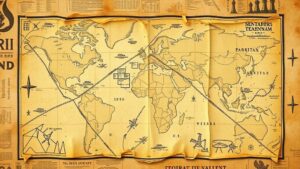Recovering Trade Goods Near Historic Tribal Migration Routes
Recovering Trade Goods Near Historic Tribal Migration Routes
The study of trade goods recovered along historic tribal migration routes provides invaluable insight into the social, economic, and cultural dynamics of indigenous communities. These routes, often characterized by their fluidity and adaptability, serve as a testament to the interconnectedness of tribal societies and the exchange of goods that fostered relationships across vast distances. This article explores the significance of recovering trade goods near these routes, examining the methods employed, the findings from recent research, and the implications for our understanding of tribal histories.
The Importance of Trade Goods in Tribal Societies
Trade goods–items exchanged between tribes–are critical for understanding the economic practices and cultural interactions of indigenous peoples. e goods often included tools, pottery, textiles, and raw materials, which were not only functional but also held cultural significance.
- Trade goods reflect technological advancements, demonstrating how tribes adapted to their environment.
- Items such as shells and obsidian illustrate long-distance trade, highlighting social networks that transcended regional boundaries.
For example, the discovery of pottery from the Mimbres culture in areas far beyond their original geographic location indicates that these goods were highly sought after for trade. Such findings underscore how trade facilitated cultural exchange, enriching tribal identities and fostering collaboration.
Archaeological excavation remains a primary method for recovering trade goods along historic migration routes. Researchers employ a variety of techniques to uncover artifacts, including stratigraphic excavation, which involves digging through layers of soil to preserve the context of findings.
- Stratigraphic Excavation: This method allows archaeologists to understand the chronological sequence of human activity in an area.
- Remote Sensing: Technologies such as ground-penetrating radar help locate buried artifacts without extensive digging.
Field surveys are also essential, allowing archaeologists to map out areas of historical significance. In regions known for historical migration, teams often conduct systematic site surveys, recording the locations of artifacts and gathering information about previous tribal interactions. A prominent example is the survey of the Old Santa Fe Trail, where researchers unearthed tools and ceramics indicative of extensive trade networks.
Case Studies: Notable Recoveries
Several case studies highlight successful recovery of trade goods that reflect historical trade routes. One notable case is the excavation at the Cahokia Mounds site in Illinois, where thousands of artifacts, including trade beads and ceremonial objects, were unearthed. e finds suggest that Cahokia served as a major trade hub, facilitating interactions among tribes from across the Midwest.
Another example comes from the Santa Cruz River Basin in Arizona, where archeologists discovered obsidian blades and shell ornaments that point to trade relationships with tribes in the Pacific Coast region. This evidence demonstrates not only the economic transactions but also the cultural exchanges that influenced tribal identities and practices.
Implications for Understanding Tribal Histories
The recovery of trade goods provides profound insights into the histories of tribal societies. It emphasizes the importance of trade in the development of social hierarchies, cultural exchanges, and technological advancements. Understanding the flows of goods allows researchers to piece together narratives about migration patterns, inter-tribal relationships, and shifts in cultural practices.
- Assessing the types of goods traded helps identify dominant cultural influences and technological advancements.
- Analysis of trade routes reveals how tribes adapted to environmental changes and socio-political challenges.
Also, contemporary implications also arise from these studies. As modern researchers engage with tribal communities, the recovery of trade goods can lead to restored narratives and a deeper appreciation for ancestral ties. Ethnoarchaeological approaches, which emphasize ongoing relationships between communities and their historical contexts, are essential for promoting greater understanding and collaboration.
Challenges and Future Directions
Despite the advancements in archaeological methods, challenges persist in recovering trade goods along historic migration routes. Issues such as looting, urban development, and climate change threaten archaeological sites and artifacts. Community engagement and collaboration with indigenous peoples are vital to address these challenges, ensuring that recovery efforts respect cultural significance and promote cultural heritage preservation.
Future research must focus on interdisciplinary approaches, combining archaeology with indigenous knowledge systems to enhance recovery efforts. By integrating traditional ecological knowledge and oral histories, scholars can gain a more holistic understanding of trade practices and their significance throughout history.
Conclusion
The recovery of trade goods near historic tribal migration routes is a multifaceted endeavor with substantial implications for understanding tribal histories and cultures. Employing diverse methodologies and honoring indigenous perspectives highlights not only the economic exchanges that occurred but also the rich tapestry of relationships shaped by these interactions. As we navigate future research endeavors, it is crucial to foster collaborative partnerships that honor and reflect the histories of indigenous peoples.
In pursuing these goals, scholars and tribal communities can work together to recover not only trade goods but also the narratives and legacies that shape our understanding of the past.



